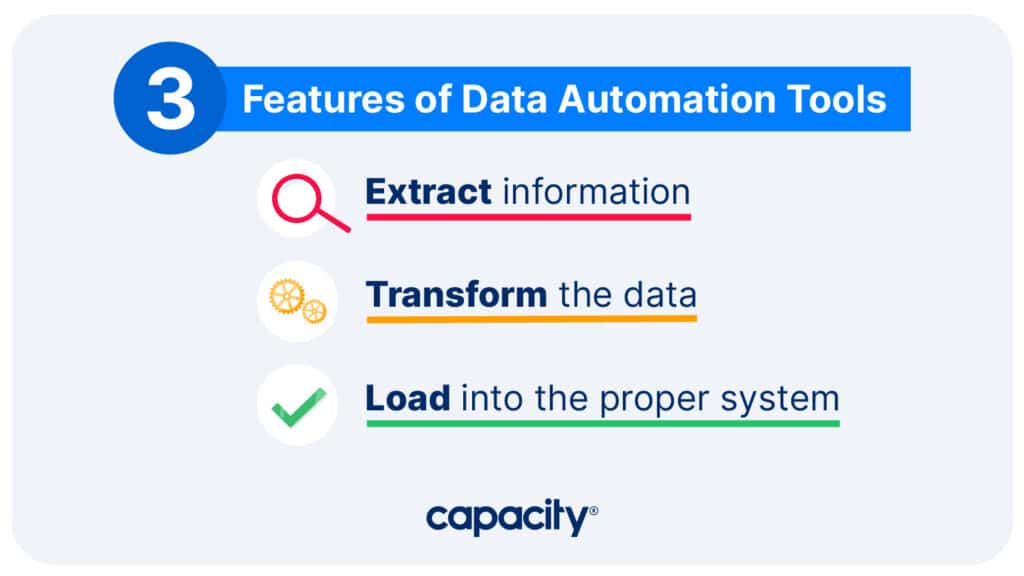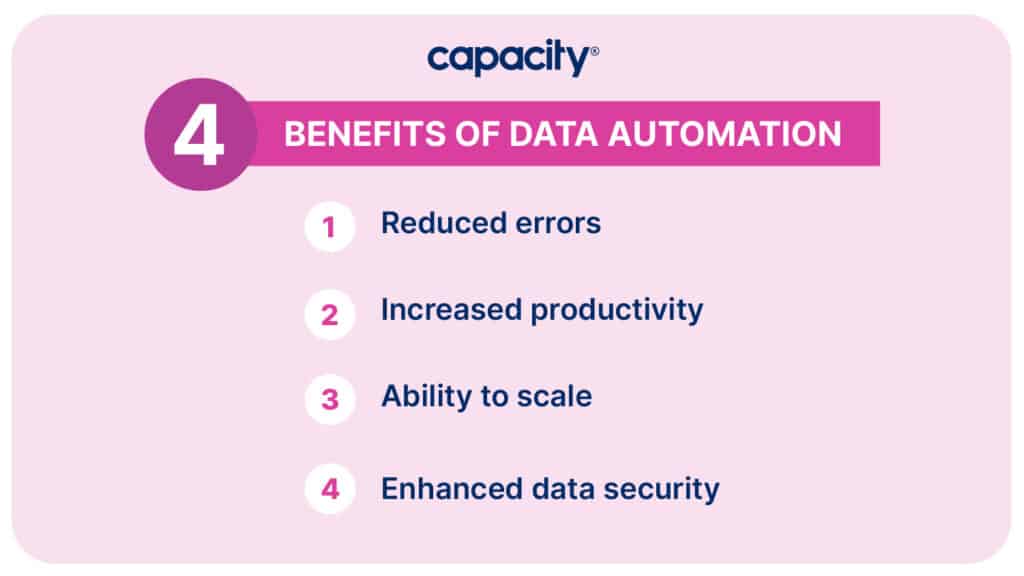Data automation is the key to unlocking a world of data-driven efficiency. By leveraging automated data processing, data collection, and data management technologies, businesses can reduce manual data entry, simplify data analysis, and improve overall data quality. In this article, we’ll explore the various benefits of data automation and how it can help organizations streamline data-related tasks and maximize data accuracy. So, let’s get started unlocking the power of data automation!
What is data automation?
Data automation is the process of using automated software to collect data, process data, and store data in databases. Automated data processing helps improve data accuracy, reduce data entry errors, and free up resources that would otherwise be spent manually managing data. Automated data processing also allows data to be accessed from multiple sources and updated in real-time, ensuring data is always up to date.

By automating data processing, companies can save both time and money. Automation also helps improve data accuracy as data can be updated quickly without errors or data entry mistakes. Additionally, data automation allows data to be accessed from anywhere at any point in time, eliminating the need for manual data gathering and data entry.

Features of data automation tools
Data automation has three fundamental components: Extract, Transform, and Load (ETL). This process can be broken down into straightforward steps:
- Extract information from a source or multiple sources
- Transform the data into the required format
- Load into the proper system, such as a knowledge base or database
Data automation tools include data extraction, data transformation, data loading, data integration, data synchronization, and data visualization. Each of these components plays an integral role in data automation, helping to ensure data is managed efficiently and cost-effectively.

4 Benefits of data automation
Data automation helps companies of all shapes and sizes easily streamline cluttered information. Next, take a look at a few of the top benefits of data automation solutions:
1. Reduced errors
Data automation is transforming the way we interact with data. Cutting-edge algorithmic techniques are revolutionizing the need for human input, allowing us to focus on more complex tasks such as analysis, decision-making, and management. This doesn’t mean that humans aren’t needed for data systems; instead, they can contribute much more than before. These advanced technologies reduce our chances of making errors while increasing efficiency across all areas.
2. Increased productivity
Employees can complete tedious tasks in less time by eliminating manual processes and allowing AI chatbots to handle the time-consuming work. This frees up their schedule so they may focus on more value-adding activities.
With data automation, you can effortlessly process mountains of data with minimal human involvement. It is more productive than humans, and it runs 24/7. Plus, not only does your business save time but money as well!
3. Ability to scale
Data automation is a cost-efficient solution for businesses of any size. Through it, you can track critical data points, distill insights from them, and compile all that information into one brief report – no human help required! This makes distributing the findings to different departments or stakeholders easy as pie. Additionally, data automation helps businesses scale up quickly and efficiently as data is easily shared and reused.
4. Enhanced data security
Data automation helps to improve data security as data is not exposed to human errors or manipulation. Automated data solutions also offer data encryption and secure data storage, essential for ensuring data privacy and security. Furthermore, data automation can create automatic backups and audit trails that ensure all data is stored securely and accurately.
In conclusion, data automation is the key to unlocking data’s full potential by providing a cost-effective solution that helps to improve data accuracy, reduce errors, save time, and increase data security. It’s an essential technology for companies of all sizes looking to stay competitive in today’s data-driven world.

Top 5 Data automation tools
Choosing data automation software can be tricky. We’ve rounded up a few of the best platforms to consider:
1. Capacity
Capacity is a support automation platform that offers robust data automation capabilities. The AI-powered platform has an intelligent knowledge base that helps streamline customer and employee inquiries. The platform enables businesses to automate data-intensive processes quickly and efficiently with minimal human involvement. Capacity’s intuitive design makes it easy to use and configure. Additionally, you can sign up for a free trial.
2. Skyvia
Skyvia is an automated data integration platform that helps accelerate data migration and synchronization between cloud applications and data warehouses. It also provides data quality, data validation, and data profiling capabilities.
3. Talend
Talend is an automated data integration platform that helps to bridge the gap between disparate systems by extracting data from various sources and transforming it into a unified format. It also includes robust data profiling, quality, and auditing capabilities.
4. Fivetran
Fivetran is an automated data pipeline that helps to streamline data collection from different sources into a single data warehouse. It’s secure, reliable, and easy to use.
5. Matillion ETL
Matillion ETL is an automated data integration and transformation tool that helps collect data from different sources, transform it into a unified format, and load it into data warehouses such as Snowflake or Redshift. It provides data profiling, data auditing, and data validation capabilities.
How does AI play a role in data automation?
AI plays a significant role in data automation. AI-driven automated data collection and processing revolutionize how data is collected, processed, and stored. Automated data processing can quickly gather information and documents from multiple sources without manual input. It also helps reduce errors associated with manual data entry by allowing for automated data validation and transformation.
AI-powered automated data processing uses advanced algorithms to analyze data to identify patterns, trends, and correlations quickly. This enables organizations to gain deeper insights into their data and make more informed decisions faster. Additionally, AI can be used for data cleaning and integration to consolidate disparate data sources into a single data warehouse for long-term storage.

How to automate data entry in 4 steps
Businesses can get started automating data in four simple steps:
1. Identify data sources
The first step to data automation is identifying the data sources you want to use for data collection. This includes collecting data from internal resources such as spreadsheets, databases, and third-party APIs. To accomplish this task, it is important to determine which data sources will provide the most accurate input.
2. Create data processing rules
After identifying data sources, you will need to create data processing rules that determine how data should be processed. This includes specifying data formats, transformations, quality checks, and more.
3. Integrate data sources
Integrating data sources is essential for data automation, allowing businesses to quickly collect data from multiple sources. Companies can get a more comprehensive picture of their data landscape by leveraging data from various sources. This data can then be used to make informed decisions, drive insights, and develop data-driven strategies. Integrating data sources also helps businesses automate data processes and increase data accuracy, making data automation more efficient and reliable.
4. Automate data processing
The last step is to automate data processing. This can range from simple data entry automation tasks, such as copying/pasting data from one system to another, to more complex data manipulation and analytics tasks that require advanced data science skills.
By following these steps, data automation can help you streamline data collection and processing tasks for increased accuracy, efficiency, and security. With data automation in place, businesses of any size can take advantage of the power of data to stay competitive in today’s market.
Data automation with Capacity
In conclusion, manually updating databases and knowledge repositories can be an exhausting, tedious task. Capacity makes it simple.
Capacity’s intelligent knowledge base can instantly add common FAQs and information into a database for future use without any human intervention.
Learn more in a personalized demo, or try it for free today!





